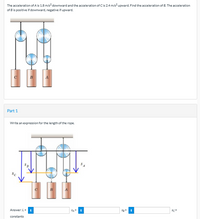
International Edition---engineering Mechanics: Statics, 4th Edition
4th Edition
ISBN: 9781305501607
Author: Andrew Pytel And Jaan Kiusalaas
Publisher: CENGAGE L
expand_more
expand_more
format_list_bulleted
Concept explainers
Question

Transcribed Image Text:The acceleration of A is 1.8 m/s downward and the acceleration of Cis 2.4 m/s² upward. Find the acceleration of B. The acceleration
of B is positive if downward, negative if upward.
C
B
A
Part 1
Write an expression for the length of the rope.
B
A
Answer: L=
SA+
Sg+
sc+
constants
Expert Solution
This question has been solved!
Explore an expertly crafted, step-by-step solution for a thorough understanding of key concepts.
Step by stepSolved in 2 steps with 1 images

Knowledge Booster
Learn more about
Need a deep-dive on the concept behind this application? Look no further. Learn more about this topic, mechanical-engineering and related others by exploring similar questions and additional content below.Similar questions
- Please solve for: -Magnitude of acceleration of the rocket in m/s^2-Direction of acceleration of the rocket relative to the ground in degrees Box these answers, the unknowns that are asked for in the problem statement aren't necessary. v = 6 m/s^2p = 3000 kmarrow_forwardFind the magnatidue of VB(ft/s): Find the angle of VB(degrees)arrow_forward3. Find {g#}E, the acceleration of gravity at a point p relative to the Earth as represented in FE (ft/s?). Use |g| = g = 32.174 ft/s². The gravity vector usually does not have subscripts or superscripts as these will be suggested by context. In this problem it would simply be {g}e•arrow_forward
- use 4 decimal in the solutionarrow_forwardBungee Jump Simulation (Second order Ordinary Differential Equations) A team of engineering students is planning a bungee jumping trip. One of the preparation tasks is to write a MATLAB program to simulate high-altitude bungee jumping using a 150-meter bungee line. The purpose of the simulation is to estimate the peak acceleration, velocity, and drop distance of the jump to ensure that the arresting force of the bungee is not too great and the jump off point is high enough so that no one will hit the ground. The equation to use for the analysis is Newton's Second Law, F = ma where F is the sum of the gravitational, aerodynamic drag, and bungee forces acting on the jumper, m is the mass of the jumper (which is 70 kg), and a is the acceleration. Define the distance the jumper falls as the variable x (which is a function of time, x(t)). The jumper's velocity and acceleration are then represented as x' and x", respectively. The Newton's equation to solve for acceleration: x" = F/m Next,…arrow_forwardNeed asaparrow_forward
- I need the answer as soon as possible please.arrow_forwardFind the acceleration of the specified object. (Hint: Recall that if a variable is changing at a constant rate, its acceleration is zero.) A boat is pulled into a dock by means of a winch 2 meters above the deck of the boat (see figure). The winch pulls in rope at a rate of 1.7 meters per second. Find the acceleration (in m/sec?) of the boat when there is a total of 5.2 meters of rope out. (Round your answer to three decimal places.) m/sec2 Not drawn to scale Submit Answerarrow_forwardThe velocity of A is 1.7 m/s downward, the velocity of B is 2.6 m/s upward, and the velocity of D is 3.1 m/s downward. Find the velocity of C. The velocity of C is positive if downward, negative if upward. D B Answer: vc= i C ! m/sarrow_forward
- basic problem , Please solve fast with fbdarrow_forwardRelative Motion Analysis using Rotating Axes, use the formulas attached to find the solution to the problem, in addition you can use Relative motion using translating axes to find velocity and acceleration of D and E, but to find the velocity of C you must use the rotating axis formula given, the formula given is a general formula. State which where the axis XYZ and xyz will be. Solve in vector form.arrow_forwardPA-2 m/s -45 Given: Block A is moving down at 2 m/s. Find: The velocity of B at the instant 0=45°. Plan: Establish the fixed x-y directions and draw a kinematic diagram. 2. Express each of the velocity vectors in terms of their i, j, k components and solve vB VA+ @ X FB/Aarrow_forward
arrow_back_ios
SEE MORE QUESTIONS
arrow_forward_ios
Recommended textbooks for you
 International Edition---engineering Mechanics: St...Mechanical EngineeringISBN:9781305501607Author:Andrew Pytel And Jaan KiusalaasPublisher:CENGAGE L
International Edition---engineering Mechanics: St...Mechanical EngineeringISBN:9781305501607Author:Andrew Pytel And Jaan KiusalaasPublisher:CENGAGE L

International Edition---engineering Mechanics: St...
Mechanical Engineering
ISBN:9781305501607
Author:Andrew Pytel And Jaan Kiusalaas
Publisher:CENGAGE L